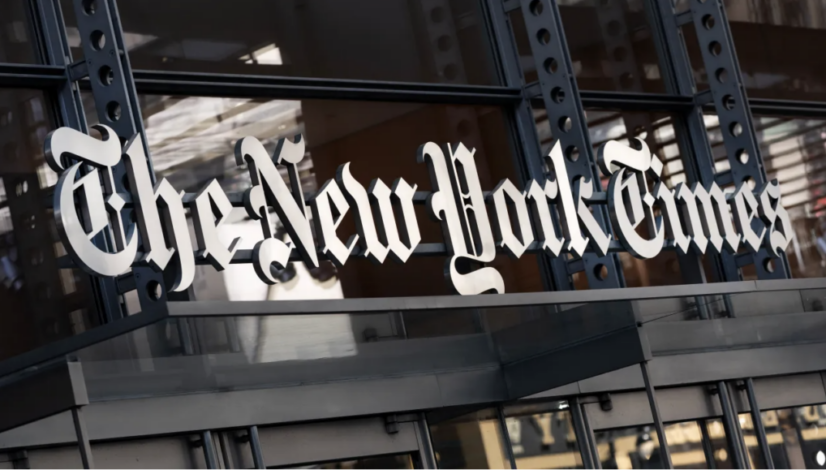Why the New York Times’s Jan. 6 U-turn is a big deal

Is The New York Times going soft on the January 6 rioters? Maybe beginning to doubt their lopsided coverage of the events of that day? Starting to think the Justice Department’s investigation into the protests, deemed “the biggest criminal inquiry in the Justice Department’s 153-year history,” is just a bit over the top?
Or are they worried that newly released footage will reveal a different story than that told by the biased House investigation used to impeach former President Trump?
Thanks to Mike Johnson, Americans have an opportunity to challenge Democrats’ accusation that many hundreds of Donald Trump supporters engaged in a violent “insurrection.” The new Republican Speaker of the House recently released 44,000 hours of video tapes, including security video from the Capitol Hill police, affording us another look at what actually happened that day.
This we know: 63 days after the election of 2020, supporters of Donald Trump marched to the Capitol. Some were armed and dangerous, intent on disrupting the peaceful transfer of power to newly elected Joe Biden. Others were not, but believed that Democrats stole the election, and followed the throngs who headed toward Congress ready to protest the theft. Some got caught up in the moment, stayed clear of the violence that followed but were later hunted down and imprisoned.
One such participant is the subject of a lengthy and compassionate story published by the Times two days after the release of the new tapes. It concerns a Wisconsin man thrown in jail because his son turned him into the FBI. The father, Brian Mock, is introduced as a political moderate, a landscaper who occasionally voted Republican but who also voted for Barack Obama. He is portrayed as an utterly decent and law-abiding man who is an “advocate for the homeless” and who supported his son when he came out as gay.
In the article, Mock, who was convicted of 11 charges relating to the riot but has not yet been sentenced, is trying to make his son understand how he got caught up in the rowdy crowd, and why he is photographed pushing a police officer. He has been warned by his lawyers that he could spend several years in prison, even though he never set foot inside the Capitol and, according to him, only laid a hand on the cop when he thought he was going for his weapon.
Watching video of the event, he says, “There were throngs of people, like a river. You’re in the current. You’re getting pushed … I had a concussion grenade go off and explode right on me. … Can you see how that would provoke a crowd?”
“I’m not some lunatic frothing at the mouth. I got in a bad situation for about five minutes. Do you see where I’m coming from?”
A great many Americans will see where Mock, who went to D.C. after hearing Trump declare the election stolen, is coming from. In a CNN poll conducted this past summer, only 29 percent of Republicans and right-leaning independents thought Biden’s election was legitimate, while 69 percent did not. Of the country overall, 38 percent think Biden is an illegitimate president. Given the concerted effort by the liberal media to squash such doubts and the ongoing vilification of “election-deniers,” that figure — roughly the same as it was on January 6 — is troubling.
Through Aug. 4, more than 1,100 people faced criminal charges related to the events of Jan. 6; 967 for “Entering or remaining in a restricted federal building or grounds,” of which 104 were also charged with carrying a weapon; 372 for “Assaulting, resisting or impeding officers or employees”; 310 for “Corruptly obstructing, influencing or impeding an official proceeding or attempting to do so”; 115 for stealing or destroying government property; and 42 for conspiracy.
In an era when career criminals are often released without bail, large-scale theft is tolerated and progressive DAs refuse to prosecute even low-level felonies, the aggressiveness of the FBI in pursuing the Jan. 6 attendees hits a nerve. Many consider it politically motivated and yet another example of what some call our “two-tiered system of justice.” Joe Biden’s campaign rests on depicting “extreme MAGA Republicans,” as he calls them, as an existential threat to our democracy; nothing suits that pitch better than locking up hundreds of “insurrectionists.”
Coverage from the liberal media, and the made-for-TV depiction of events skillfully put together by House Democrats for the second impeachment trial of Donald Trump, tell one story. Certain videos, some of which were released by Tucker Carlson in April, tell another. It is clear that Democrats cherry-picked the evidence that painted Trump and his supporters in the worst possible light. Commentators on the right have done the opposite. Legitimate questions persist.
For instance, some protestors are shown being uncuffed and fist-bumped by cops, suggesting that there were undercover FBI or police in the crowd, whom some accuse of purposefully instigating the storming of the Capitol. That issue was raised last spring by Barry Loudermilk, congressman from Georgia and chairman of the House Oversight Committee, who wrote a letter to the Metropolitan Police Department asking about the presence of “plain-clothes officers.”
When Rasmussen polling asked in April (after the Tucker release): “How likely is it that undercover government agents helped provoke the Capitol riot?” 59 percent of Democrats, 62 percent of Republicans and 74 percent of Independents agreed it was likely.
When Speaker Johnson announced he would abide by an earlier promise and make the tapes public, Democrats were furious, accusing him and his GOP colleagues of breaching the security of the Capitol. Their complaints make it look like they have something to hide, and further the distrust they have sown.
Make no mistake — the riot on Jan. 6 should never have happened. But voters doubt they have the whole story; they are probably right. Maybe the Times will lead a more balanced review.



